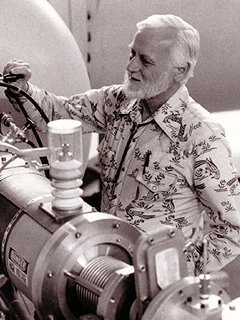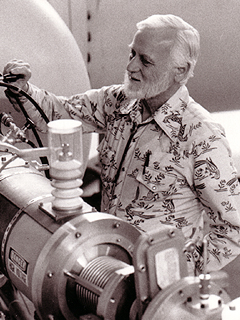Dr. Paul Edward Damon, 84, Emeritus Professor of Geosciences at the University of Arizona, died at the University Medical Center early Thursday morning, April 14, 2005 following a stroke in his office at the University on Tuesday afternoon, April 12. Memorial services will be arranged for a late May date to be set by the Pima Friends Meeting (Quakers) of which he was a long-time active member.
Survivors include Paul's sister, Lucille Damon Gallo of Palm Coast, Florida, nieces Ellen Gallo Verdi also of Palm Coast, Bonnie Burchardt Crocetti of Boonton, New Jersey, and their families, as well as his wife of 58 years, Mary Janet "Jinx" Winter Damon and sons Timothy Winter Damon and his wife Diane, of Tucson and Dr. John Edward Damon and his wife Mariana and two grandsons, Edward Angus (Ned) and William George of Kearney, Nebraska, all formerly of Tucson.
_________
The Arizona Daily Star, Tucson, April 23, 2005
UA scientist Paul Damon dies
Expert helped pioneer use of carbon dating
Paul E. Damon, a geoscientist whose work helped make the University of Arizona internationally famous for isotope geochemistry, died Thursday, April 14, in Tucson. He was 84.
Damon's research covered subjects ranging from atmospheric evolution to paleoclimatology. Among his other achievements, in 1988 he and colleagues at the UA dated the Shroud of Turin - a centuries-old linen cloth bearing the likeness of a crucified man - and the Dead Sea Scrolls.
In a press release issue by the university Friday, Vice Provost George Davis said Damon was a dedicated scholar and intellect as well as an effective mentor. Joaquin Ruiz, dean of the College of Science, called Damon "one of the most extraordinary individuals I ever met" and recalled that he was so well-loved in Mexico, where he did much of his research, that he'd been dubbed "San Pablo" by residents near his study sites.
A native of Brooklawn, N.J., Damon earned a bachelor's degree in 1943 from Bucknell University. After serving in the U.S. Navy in World War II, he earned a master's degree from the Missouri School of Mines and Metallurgy in 1949. He was a research associate at the University of Arkansas from 1949 to 1950 and an assistant professor from 1951 to 1954. He received his doctorate from Columbia University in 1957 and joined the UA faculty the same year.
In the 1980s, Damon was a pioneer in the carbon-14, or radiocarbon, method for dating organic material - and was instrumental in helping the UA acquire cutting-edge technology to age trees, baskets and clothing, ancient pack-rat nests, coral reefs and art, among other objects. He applied his knowledge to scientific problems in geochemistry, paleoclimatology, the evolution of the atmosphere and the origins of ore deposits and volcanic rocks. He was among the first to detect the signature of solar flares in tree rings using radiocarbon measurements.
He retired from the university as an emeritus professor of geosciences in 1989 - but colleagues say right up until his death, he was conducting research on how solar variability affects climate.
Damon is survived by Mary Janet "Jinx" Winter Damon, his wife of 58 years; his sister Lucille Damon Gallo; two sons, Timothy and John; two nieces and two grandsons.
A memorial service is being planned for late May in Tucson.
_____
Tucson Citizen (AZ) - April 22, 2005
Paul E. Damon, University of Arizona emeritus professor of geosciences, was doing what he loved most when he suffered a stroke in his office and died two days later on April 14. He was 84. A memorial service in May is being arranged.
"He was feeling well, and he was working at what he wanted to do," his wife, Mary Janet "Jinx" (Winter) Damon, said in a telephone interview yesterday. "He was working on a paper on global climate change. His colleagues said they would finish up the job. "He had had a little stroke … in December, but he was doing well."
His long career took him to dozens of countries, but he recently decided to spend more time at home, she said. "We were planning on just staying home and reading good books. He had many interests from reading to history to gardening. He enjoyed his students, and he was very fond of the university faculty. "He will be missed. We have been happily married all these years."
The couple moved to Tucson in 1957 so he could take a position at UA after he had been awarded a doctorate from the University of Arkansas, Damon said. He received his bachelor's degree at Bucknell University in Pennsylvania and immediately entered the Navy in 1943.
He served as a Navy officer during World War II, she said. After the war, the couple were married, and he entered the Missouri School of Mines, she said. During his long career, "he traveled all over the world, but not in South America, except Venezuela, and only Egypt in Africa."
One of his more celebrated tasks at UA might have been his involvement in 1989 in radiocarbon dating a tiny shred of material some suspected of being from a "lost painting" of Leonardo da Vinci, she said. Those who hoped the material came from da Vinci were disappointed.
Or it could have been his work on the Shroud of Turin. According to a 1988 Tucson Citizen story, Mr. Damon and UA physicist Douglas J. Donahue tested a bit of the fabric and found it dated only to 1260. But he also was known for his study of geology and his study of solar flares and their effects on astronauts.
He also was active in human-rights causes, his wife said. And the couple were active with Pima Friends Meeting, 931 N. Fifth Ave.
In addition to his wife, Mr. Damon is survived by his sister, Lucille Gallo of Palm Coast, Fla.; sons Timothy Winter Damon of Tucson and John Damon of Kearney, Neb.; and two grandsons.
Dr. Paul Edward Damon, 84, Emeritus Professor of Geosciences at the University of Arizona, died at the University Medical Center early Thursday morning, April 14, 2005 following a stroke in his office at the University on Tuesday afternoon, April 12. Memorial services will be arranged for a late May date to be set by the Pima Friends Meeting (Quakers) of which he was a long-time active member.
Survivors include Paul's sister, Lucille Damon Gallo of Palm Coast, Florida, nieces Ellen Gallo Verdi also of Palm Coast, Bonnie Burchardt Crocetti of Boonton, New Jersey, and their families, as well as his wife of 58 years, Mary Janet "Jinx" Winter Damon and sons Timothy Winter Damon and his wife Diane, of Tucson and Dr. John Edward Damon and his wife Mariana and two grandsons, Edward Angus (Ned) and William George of Kearney, Nebraska, all formerly of Tucson.
_________
The Arizona Daily Star, Tucson, April 23, 2005
UA scientist Paul Damon dies
Expert helped pioneer use of carbon dating
Paul E. Damon, a geoscientist whose work helped make the University of Arizona internationally famous for isotope geochemistry, died Thursday, April 14, in Tucson. He was 84.
Damon's research covered subjects ranging from atmospheric evolution to paleoclimatology. Among his other achievements, in 1988 he and colleagues at the UA dated the Shroud of Turin - a centuries-old linen cloth bearing the likeness of a crucified man - and the Dead Sea Scrolls.
In a press release issue by the university Friday, Vice Provost George Davis said Damon was a dedicated scholar and intellect as well as an effective mentor. Joaquin Ruiz, dean of the College of Science, called Damon "one of the most extraordinary individuals I ever met" and recalled that he was so well-loved in Mexico, where he did much of his research, that he'd been dubbed "San Pablo" by residents near his study sites.
A native of Brooklawn, N.J., Damon earned a bachelor's degree in 1943 from Bucknell University. After serving in the U.S. Navy in World War II, he earned a master's degree from the Missouri School of Mines and Metallurgy in 1949. He was a research associate at the University of Arkansas from 1949 to 1950 and an assistant professor from 1951 to 1954. He received his doctorate from Columbia University in 1957 and joined the UA faculty the same year.
In the 1980s, Damon was a pioneer in the carbon-14, or radiocarbon, method for dating organic material - and was instrumental in helping the UA acquire cutting-edge technology to age trees, baskets and clothing, ancient pack-rat nests, coral reefs and art, among other objects. He applied his knowledge to scientific problems in geochemistry, paleoclimatology, the evolution of the atmosphere and the origins of ore deposits and volcanic rocks. He was among the first to detect the signature of solar flares in tree rings using radiocarbon measurements.
He retired from the university as an emeritus professor of geosciences in 1989 - but colleagues say right up until his death, he was conducting research on how solar variability affects climate.
Damon is survived by Mary Janet "Jinx" Winter Damon, his wife of 58 years; his sister Lucille Damon Gallo; two sons, Timothy and John; two nieces and two grandsons.
A memorial service is being planned for late May in Tucson.
_____
Tucson Citizen (AZ) - April 22, 2005
Paul E. Damon, University of Arizona emeritus professor of geosciences, was doing what he loved most when he suffered a stroke in his office and died two days later on April 14. He was 84. A memorial service in May is being arranged.
"He was feeling well, and he was working at what he wanted to do," his wife, Mary Janet "Jinx" (Winter) Damon, said in a telephone interview yesterday. "He was working on a paper on global climate change. His colleagues said they would finish up the job. "He had had a little stroke … in December, but he was doing well."
His long career took him to dozens of countries, but he recently decided to spend more time at home, she said. "We were planning on just staying home and reading good books. He had many interests from reading to history to gardening. He enjoyed his students, and he was very fond of the university faculty. "He will be missed. We have been happily married all these years."
The couple moved to Tucson in 1957 so he could take a position at UA after he had been awarded a doctorate from the University of Arkansas, Damon said. He received his bachelor's degree at Bucknell University in Pennsylvania and immediately entered the Navy in 1943.
He served as a Navy officer during World War II, she said. After the war, the couple were married, and he entered the Missouri School of Mines, she said. During his long career, "he traveled all over the world, but not in South America, except Venezuela, and only Egypt in Africa."
One of his more celebrated tasks at UA might have been his involvement in 1989 in radiocarbon dating a tiny shred of material some suspected of being from a "lost painting" of Leonardo da Vinci, she said. Those who hoped the material came from da Vinci were disappointed.
Or it could have been his work on the Shroud of Turin. According to a 1988 Tucson Citizen story, Mr. Damon and UA physicist Douglas J. Donahue tested a bit of the fabric and found it dated only to 1260. But he also was known for his study of geology and his study of solar flares and their effects on astronauts.
He also was active in human-rights causes, his wife said. And the couple were active with Pima Friends Meeting, 931 N. Fifth Ave.
In addition to his wife, Mr. Damon is survived by his sister, Lucille Gallo of Palm Coast, Fla.; sons Timothy Winter Damon of Tucson and John Damon of Kearney, Neb.; and two grandsons.
Family Members
Sponsored by Ancestry
Advertisement
Advertisement


